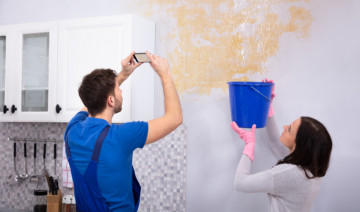
Water Damage Repair Tips
Water damage can at first seem insignificant, but if it is not repaired properly, it can lead to far greater difficulties. No matter how the damage occurred, what the source of the water may have been, or what items or materials were affected, good water damage repair will thoroughly correct the problem and restore the area to its desired dryness.
How Water Damage Occurs
There are many ways water damage can occur in any home or property. Fast water damage may be easy to see from an overflowing sink, flash flooding, a burst pipe, sudden roof damage from a storm, or a broken appliance such as a water heater or washer. Slower damage may remain hidden for some time, coming from a minor leak, excessive condensation, blocked gutters, seepage into a below ground space, or improperly installed appliances.
Regardless of the source of the water, the damage can add up quickly. Softened or rotted wood, sheetrock, and drywall are common problems, and mold can grow extensively in any damp or wet area. Water creates stains on different materials, and may warp flooring, ceilings, or walls. Extensive damage can even weaken an entire structure, leading to collapse in extreme cases.
12 Tips for Effective Water Damage Repair
Every situation is different when water damage occurs, from the source of the water to how long it has been leaking, what materials are involved, and what repair steps will be necessary. To facilitate proper water damage repair…
- Act Quickly – Repairs should begin as soon as possible after the damage is spotted. This will help minimize the extent of the damage and can make repair costs more manageable. This is especially critical if mold is a concern, as mold can grow within 24-48 hours of water intrusion.
- Unplug All Electronics – Immediately unplug all nearby electronics, even if it only appears to be a small area or a slow water leak. Water intrusion into electronics can cause dangerous short circuits that could lead to fires or severe injuries. Turning circuit breakers off is the best option.
- Stop the Water Source – As soon as the source of the water is found, take every possible step to stop the leak. This may mean turning off main valves, diverting water to a different area, or blocking water from entering the structure if possible, such as using tarps over a leaking roof.
- Remove as Much as Possible – Minimize the risk to furniture, personal items, and other materials by removing them from the wet area. This will help minimize the repairs and restoration needed, and will also make cleanup easier if there are fewer items affected.
- Dry the Area Thoroughly – Even a slightly damp area must be carefully dried before repairs can begin. This may require peeling back layers, such as pulling up carpeting to be sure the subflooring is dry or removing baseboard to ensure the bottom of the wall is dry. Even simple repairs cannot be effective on wet surfaces, such as paint that will not stick to a damp wall.
- Call Professionals – Even small leaks and repairs are better handled by experts who are properly equipped for all job sizes, no matter how the leak occurred or what the extent of the damage may be. Water repair companies have industrial fans, suction hoses, and dehumidifiers that can more quickly extract water so repairs can begin right away. Once the water is removed, professionals can assess the damage and recommend safe, efficient repairs.
- Test the Water – If the water source may be unknown, it is critical to test for contaminants. Not only will this raise an alert if there may be concerns about potential toxins, but testing the water can help guide the most effective cleanup and repair strategies.
- Document Damage and Repairs – Depending on the type of damage, how it occurs, and what insurance may be on the property, it may be possible to recoup some water damage repair costs through insurance claims or, in contested cases, through court action. This will require proper documentation, however, including records of service and repairs, receipts for work, and photos or video of the damage and repair process.
- Clean Properly – If materials can be salvaged, they must be properly cleaned, disinfected, and deodorized. Different methods will be necessary for different materials, such as cleaning carpet, paint, clothing, upholstery, woodwork, concrete, brick, or other materials. Appropriate techniques will also be necessary to prevent additional damage from improper cleaning.
- Assess Necessary Repairs – If materials are too damaged to clean and restore, carefully note what will need repair and how to make those repairs effectively to match the materials, style, and design of the space. When estimating areas for repair, it is better to overestimate the borders of water damage to be sure all affected materials are replaced as needed.
- Check Building Codes – When making repairs, it may not be sufficient to simply restore the space to its original specifications. In older buildings, safety codes may have significantly changed since the original construction, and it may now be necessary to update materials or design to meet current codes.
- Match Finishes Carefully – Even minor water damage can cause subtle color or textural changes to paint, varnish, and other finishes. Similarly, if materials were in place for a number of years before the water damage occurred, they may have naturally faded and will no longer match fresh, new materials. Check finishes carefully to ensure a seamless repair.
After the Repair
Once water damage repairs have been made, it is best to have the area professionally inspected for mold or other issues. This will help certify the correct repairs, and catch any remaining issues before more severe problems develop. In cases of extreme damage, it may be best to schedule a second inspection several months later to double-check for continuing water intrusion or the presence of mold. In the end, the cost of a second inspection will be much lower than the possibility of additional repairs.
Water damage may seem simple, but it can very complex to repair properly. By taking care to remove all the water, dry the area thoroughly, and repair it professionally, it is possible to fix water damage so it never seems to have happened at all.
